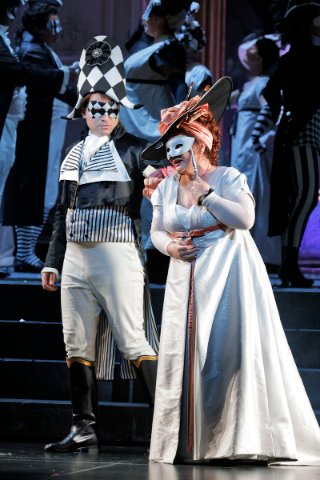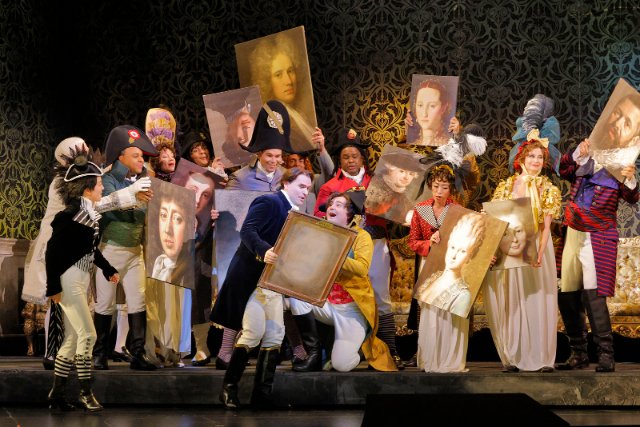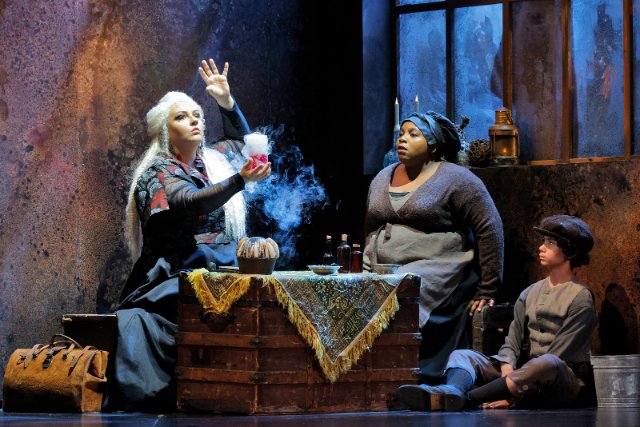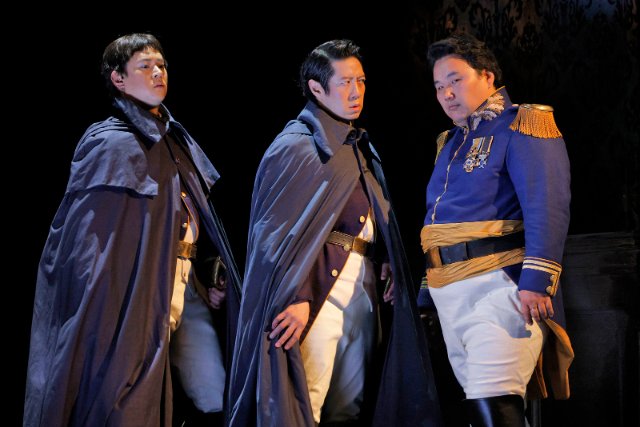Un Ballo in Maschera
San Franciso Opera's Outstanding Production
By: Victor Cordell - Sep 13, 2024
Exquisite music remarkably performed by principals, chorus, and orchestra to tantalize the ears. A colorful and tragic plot based on real history to provoke the mind. Dazzling staging to please the eyes. What’s not to like about San Francisco Opera’s production of Giuseppe Verdi’s Un Ballo in Maschera.
Like much 19th century Italian opera, Ballo suffered birthing pains because of censorship. Popular with the masses but not with nobles, Gustavus III of Sweden, who is the focal character of Ballo, was assassinated in 1792. But to placate the censors, Verdi re-set the story to Colonial America, a rare venue for opera in its era. Today, many companies, including San Francisco Opera use the originally intended setting.
In the central thread, Gustavus and Amelia love one another, but she is married to his best friend and military chief Renato. The furtive couple’s love is unconsummated, but when discovered in a rendezvous, Renato’s fury leads him ultimately to regicide.
While it lacks the number of memorable set pieces of Verdi’s fertile middle period trio, Rigoletto, Il Trovatore, and La Traviata, the 1859 score of Ballo teems with uncommon innovation and rare Verdi eclecticism. The first bit of genius is its rare balance of drama with comedy.
Throughout, the page Oscar is a flighty, humorous figure, but his shenanigans don’t disrupt the overall tone. Performed with spritely charm and precise soprano voice by Mei Gui Zhang, Oscar is a trousers role, a device that Verdi deplored. One possible reason for this exception was to create vocal balance. Another is that this was a code of the sort often employed to subvert censors. In real life, Gustavus was a flamboyant bisexual, and placing the Oscar character close to him implies that by indirection.
Ballo brims with beautiful and complex ensembles from duets to quintets with and without chorus. Yet, many aficionados would be surprised at the near absence of love duets in Verdi’s canon, a much later exception being Otello’s “Già nella notte densa” (“Now in the dark night”). However, that and Ballo’s passionate “Teco io sto…Non sai tu” (“I am with you…Don’t you know”) when the couple meet in Act 2 make up for the otherwise absence.
As Gustavus, world-acclaimed tenor Michael Fabiano brings his burnished, dark-hued, and penetrating tenor to the fore throughout and particularly in the duet. Lianna Haroutounian is Amelia who here and elsewhere demonstrates why she also is famed, in her case for her spinto versatility and agility that contribute to both the great dramatic and lyric demands of her role.
Although Verdi had eased away from the rigid conventions of bel canto in his middle period, he does revert here to some cavatina-cabaletta set pieces like the just mentioned, as well as some coloratura. Integrating an additional style, some of his lighter music from Act 1 and the ballet from Act 3 reflect his experience in mid-century French opera form, which he had applied in Les Vêpres Siciliennes.
Renato turns from ally to antagonist upon finding that his wife and the king are in love. Meanwhile, gathered conspirators who seek to assassinate Gustavus taunt Renato with their “laughing” chorus “Va’ se di notte qui colla sposa” (“If you are here at night with your bride”). Mongolian baritone Amartuvshin Enkhbat makes his SF Opera debut as Renato and offers a deep resonant voice that fills the house, especially in his signature aria “Eri tu” (“It was you”) which bemoans Gustavus’s betrayal.
The fifth key principal, Ulrica the fortuneteller, foresees the assassination by the next person who shakes the king’s hand, but whose prediction Gustavus rebuffs. Judit Kutasi brings her strong presence and electrifying mezzo to the fore as Ulrica with shrieking highs and drops to depth charge lows that animate the memorable character.
Apart from the principals, both Eun Sun Kim’s orchestra and John Keene’s chorus are formidable. Director Leo Muscato is responsible for the overall presentation, and some of the elements of Federica Parolini’s staging are particularly striking. Although the setting seems prosaic early on, the purplish-lit, steam-infused field where the tryst and assassination conspiracy occur stands out. The final scene reveals the revolving stage that had cleverly been in use throughout, but what sets that scene apart is Silvia Aymonino’s stunning costumery with the chorus in black-and-white ball garb and the dancers in varied bright dress. In all, the combination of artistic elements supports the full breath of Verdi’s music and results in a totally compelling opera.
Un Ballo in Maschera, composed by Giuseppe Verdi, with libretto by Antonio Somma, is produced by San Francisco Opera and plays at War Memorial Opera House, 301 Van Ness Avenue, San Francisco, CA through September 27, 2024.






